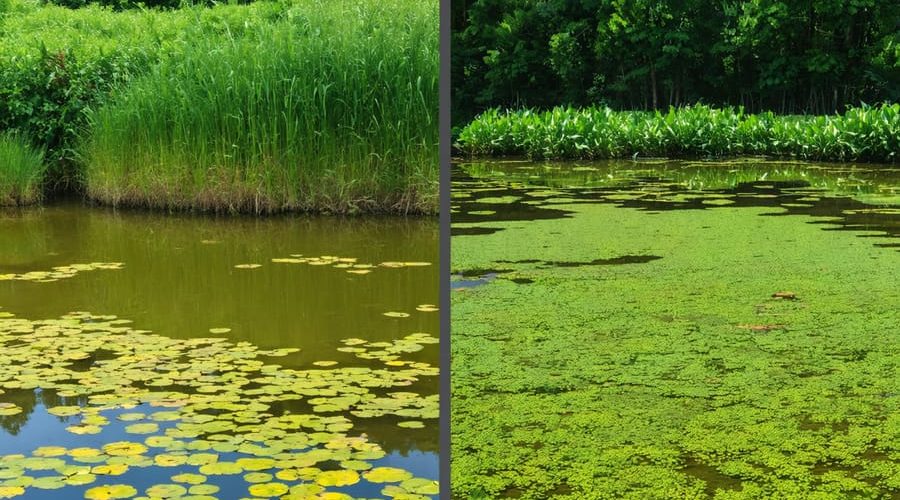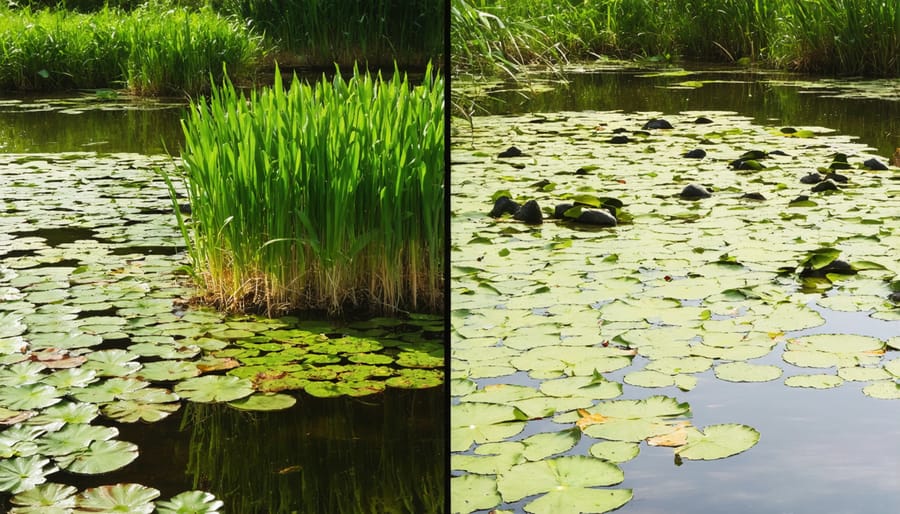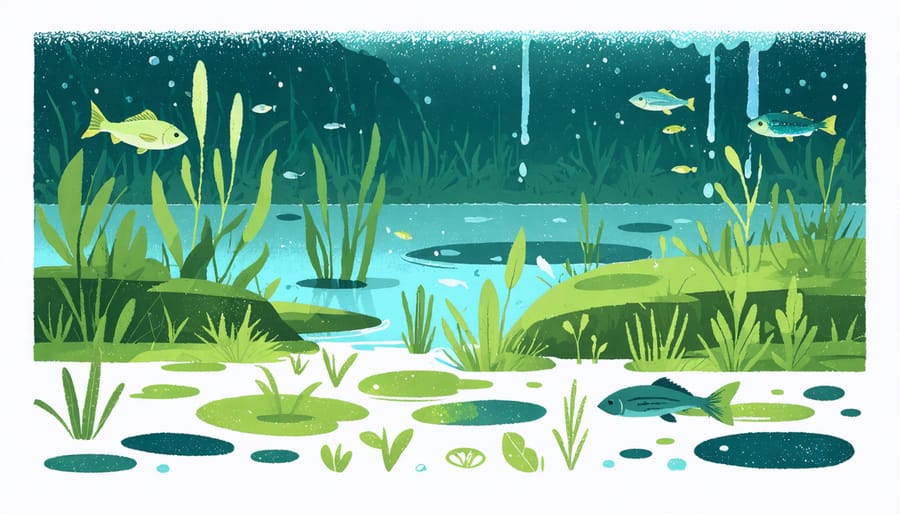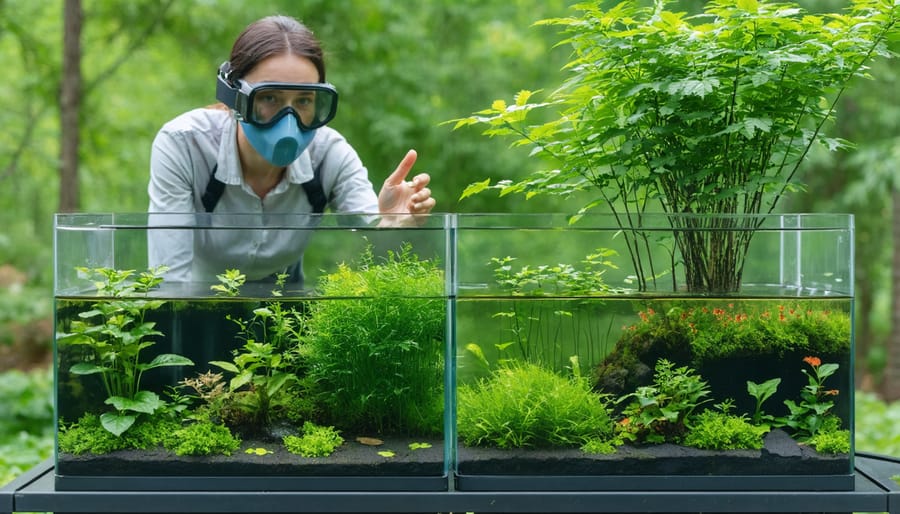
Take Control of Your Pond: Stop Invasive Species Before They Take Over
Transform your pond into a thriving aquatic ecosystem with proper management techniques that protect both wildlife and water quality. From maintaining optimal water chemistry to controlling invasive species, successful pond management requires a balanced approach that works with nature, not against it. Whether you’re dealing with algae blooms, managing fish populations, or preserving water clarity, this comprehensive guide provides practical solutions for common pond challenges. Learn time-tested strategies that blend traditional wisdom with modern scientific approaches, helping you create and maintain a healthy, sustainable water feature that enhances your property’s beauty and ecological value.
By actively monitoring and managing your pond, you’ll prevent costly problems before they develop, while creating an inviting habitat for desirable wildlife. This guide breaks down complex pond management into straightforward, actionable steps that work for ponds of any size. Whether you’re a first-time pond owner or an experienced water gardener, you’ll find practical solutions to keep your pond pristine and productive throughout every season.
Common Pond Invaders: Know Your Enemy
Aquatic Plant Invaders
While a thriving pond ecosystem is beautiful, certain invasive pond plants can quickly turn your peaceful water garden into a maintenance nightmare. Two of the most troublesome invaders are duckweed and water hyacinth, which can double their population in just a few days!
Duckweed might look harmless with its tiny, floating leaves, but don’t let its size fool you. This fast-spreading plant can form thick mats across your pond’s surface, blocking sunlight and depleting oxygen levels for fish and beneficial plants below. While some duckweed can be beneficial for natural ponds, it needs careful monitoring to prevent overtaking your water feature.
Water hyacinth, with its attractive purple flowers and glossy leaves, might seem like a lovely addition to your pond. However, this deceptive beauty is actually one of the world’s most aggressive aquatic weeds. It forms dense floating mats that can completely cover your pond’s surface, making it impossible for other plants to survive and creating stagnant conditions underneath.
Other common invaders include water lettuce, salvinia, and Eurasian watermilfoil. The key to managing these unwanted guests is early detection and prompt action. Regular monitoring of your pond helps catch these invasive species before they establish themselves and become harder to control.

Problem Fish and Animals
Every pond owner should be aware of potentially problematic fish and animals that can disrupt their pond’s ecosystem. Among the most concerning common pond pests are invasive fish species like koi carp and goldfish when not properly managed, as they can multiply rapidly and overwhelm smaller native fish populations.
Predatory animals such as herons, raccoons, and cats often view ponds as their personal buffet, targeting valuable fish and disrupting aquatic plants. These visitors can cause significant stress to your pond inhabitants and damage to your carefully planned ecosystem.
Crayfish, while natural to many water systems, can become problematic when their population explodes, as they dig burrows that may compromise pond walls and damage aquatic plants. Similarly, bullfrogs can outcompete native species and create imbalances in the pond community.
To manage these issues, consider installing protective netting or motion-activated sprinklers for deterring predators. For invasive fish control, avoid introducing non-native species and regularly monitor population levels. If you notice signs of problematic animals, such as scattered plant debris or missing fish, take action promptly to prevent the situation from worsening.
Remember, prevention is often easier than cure when it comes to problem species. Regular monitoring and quick response to new issues will help maintain your pond’s health and beauty.
Early Warning Signs: Spot Problems Fast

Visual Indicators
Regular pond inspections are essential, and knowing what to look for can help you catch problems early. Start by checking the water color – healthy pond water should be clear with a slight green tint. Murky, brown, or excessively green water indicates potential issues with water quality or algae growth.
Pay attention to your fish’s behavior. Healthy fish swim actively and come to the surface during feeding times. If you notice fish gasping at the surface or showing unusual lethargy, this could signal low oxygen levels or poor water quality.
Watch for changes in plant growth. While some aquatic plants are beneficial, sudden explosive growth or unfamiliar species could indicate invasive plants taking hold. Keep an eye on your pond edges for signs of erosion, liner exposure, or damage to stonework.
Monitor water levels regularly. Sudden drops might indicate leaks, while rises could mean drainage issues. Also, check for unusual odors – a healthy pond should have a fresh, natural smell. Any foul or swampy odors warrant investigation.
Finally, observe wildlife activity. While some visitors are welcome, excessive numbers of predators or pest species might require intervention to maintain balance.
Water Quality Changes
Invasive species can significantly impact your pond’s water quality, often in ways that aren’t immediately visible. These unwanted guests typically cause nutrient imbalances by consuming excessive amounts of oxygen and releasing waste into the water. For example, when zebra mussels invade, they filter out beneficial algae that native species depend on, leading to clearer but less healthy water.
Plants like water hyacinth and duckweed can quickly cover the water surface, blocking sunlight and reducing oxygen levels. This creates a domino effect: decreased oxygen leads to stressed fish, while decomposing plant matter increases ammonia and nitrate levels. You might notice your water becoming murky, developing an unpleasant odor, or showing signs of algae blooms.
Regular water testing becomes crucial when dealing with invasive species. Monitor pH levels, dissolved oxygen, and nutrient content at least monthly. If you spot sudden changes in water clarity or fish behavior, test immediately. Remember that prevention is easier than correction – maintaining balanced water parameters helps your pond resist invasive species’ negative impacts.
Natural Control Methods That Work
Biological Controls
Harnessing nature’s own balance system through natural pest control methods is one of the most effective ways to maintain a healthy pond ecosystem. Beneficial organisms can help control unwanted pests while contributing to your pond’s overall health.
One of the most popular biological controls is the mosquito fish (Gambusia), which feeds on mosquito larvae and other small aquatic insects. These hardy little fish are excellent additions to any pond, especially in areas where mosquitoes are a concern.
Dragonflies and damselflies are fantastic natural predators that help control flying insects around your pond. Their larvae, known as nymphs, are equally beneficial as they feed on mosquito larvae and other small aquatic pests.
Introducing beneficial bacteria can help break down organic matter and compete with harmful bacteria for nutrients, naturally maintaining water quality. These microscopic helpers are particularly effective at reducing algae growth and clarifying water.
Consider adding freshwater snails to your pond, as they’re excellent at controlling algae and consuming decaying plant matter. Just be sure to choose appropriate species that won’t harm your desired plants.
Remember that creating a balanced ecosystem takes time, but once established, these biological controls will work continuously to keep your pond healthy with minimal intervention from you.
Physical Removal Techniques
Physical removal is one of the most environmentally friendly ways to manage unwanted pond elements. For smaller ponds, hand-pulling weeds and algae can be highly effective when done regularly. Use a long-handled rake or pond net to reach deeper areas, and always remove the pulled material from the pond to prevent decomposition and nutrient release back into the water.
Pond skimmers and vacuum cleaners are excellent tools for removing floating debris, leaves, and settled organic matter. When using a pond vacuum, work slowly from shallow to deeper areas to minimize water disturbance and avoid stirring up sediment. For larger ponds, consider investing in a mechanical harvester or weed cutter, which can clear significant areas of aquatic vegetation efficiently.
During physical removal, it’s important to wear waterproof gloves and boots to protect yourself. Try to remove as much of the root system as possible when dealing with invasive plants to prevent regrowth. Creating a schedule for regular maintenance, such as weekly skimming and monthly deep cleaning, helps prevent problems from becoming overwhelming.
Remember to dispose of removed materials properly – they can make excellent compost when mixed with other organic matter, but ensure any invasive species are completely dried out first to prevent spread. For best results, combine physical removal with other management techniques for a comprehensive approach to pond maintenance.
Prevention: Your First Line of Defense
Quarantine Procedures
Introducing new plants and fish to your pond requires careful quarantine procedures to prevent diseases, parasites, and invasive species from affecting your existing ecosystem. Before adding any new inhabitants, set up a separate quarantine tank or container with similar water conditions to your main pond.
For new fish, maintain them in quarantine for at least two weeks. During this period, observe them closely for signs of illness, unusual behavior, or visible parasites. Keep the quarantine water temperature consistent and perform regular water quality tests. If you notice any health issues, treat them in the quarantine setup rather than risking exposure to your main pond population.
When it comes to plants, inspect them thoroughly for snails, eggs, or unwanted hitchhikers. Gently rinse the roots and leaves with clean water, removing any debris or foreign matter. Consider a mild potassium permanganate dip for bareroot plants to eliminate potential pathogens. Quarantine new plants in a separate container for 7-10 days, watching for any signs of decay or pest infestation.
During the quarantine period, use dedicated equipment for the isolation area to prevent cross-contamination. This includes nets, buckets, and testing equipment. Clean and sanitize these tools before using them in your main pond again.
Only introduce new additions to your pond when you’re confident they’re healthy and pest-free. Even after the quarantine period, monitor your pond closely for several weeks to ensure no issues develop. Remember, a few weeks of patience during quarantine can prevent months of problems in your main pond.

Maintenance Practices
Regular pond maintenance is your best defense against pest problems and can save you countless hours of troubleshooting later. A well-maintained pond naturally discourages unwanted visitors and creates a thriving ecosystem for your desired aquatic life. By following these preventive maintenance solutions, you’ll keep your pond healthy and pest-free.
Start with weekly skimming to remove fallen leaves and debris. This simple task prevents organic matter from decomposing in your pond and creating conditions that attract pests. Keep your pond’s edges trimmed and clear of tall grass where unwanted creatures might hide.
Monitor your water quality regularly using basic test kits. Maintain proper pH levels (between 6.8 and 7.2) and ensure adequate oxygen circulation through functioning pumps and filters. Clean your filters monthly, and don’t forget to check for any cracks or damage that might serve as entry points for pests.
Add beneficial plants that naturally repel common pond pests. Water lilies provide shade and protection for fish while discouraging algae growth. Marginal plants around the pond’s edge can deter unwanted visitors like herons and raccoons.
Inspect your fish regularly for signs of stress or illness, as healthy fish are more resistant to parasites and disease. Feed them appropriate amounts – overfeeding leads to excess waste and poor water quality, which attracts pests.
Remember to maintain consistent water levels and remove any algae buildup promptly. These routine tasks might seem simple, but they’re your first line of defense against more serious pest problems.
Managing a pond is an ongoing journey that rewards dedication and careful attention. By following the guidelines we’ve discussed throughout this guide, you can create and maintain a thriving aquatic ecosystem that brings joy and beauty to your outdoor space. Remember that successful pond management relies on regular monitoring, preventive maintenance, and quick response to potential issues.
The key to a healthy pond lies in maintaining proper water quality, controlling algae growth, managing aquatic plants, and ensuring the well-being of your fish population. Don’t wait for problems to arise – establish a regular maintenance schedule and stick to it. Small, consistent efforts can prevent major issues down the road.
Keep a watchful eye on your pond’s ecosystem throughout the changing seasons. Spring cleanup, summer maintenance, fall preparation, and winter protection each play vital roles in your pond’s annual cycle. Document your observations and maintenance activities to help you learn from experience and fine-tune your management approach.
Remember that every pond is unique, and it may take time to find the perfect balance for your specific situation. Don’t be afraid to adjust your management strategies as needed, and don’t hesitate to seek advice from local experts or fellow pond enthusiasts when challenges arise. With patience and dedication, you’ll develop an intuitive understanding of your pond’s needs and create a beautiful, sustainable water feature that you can enjoy for years to come.
